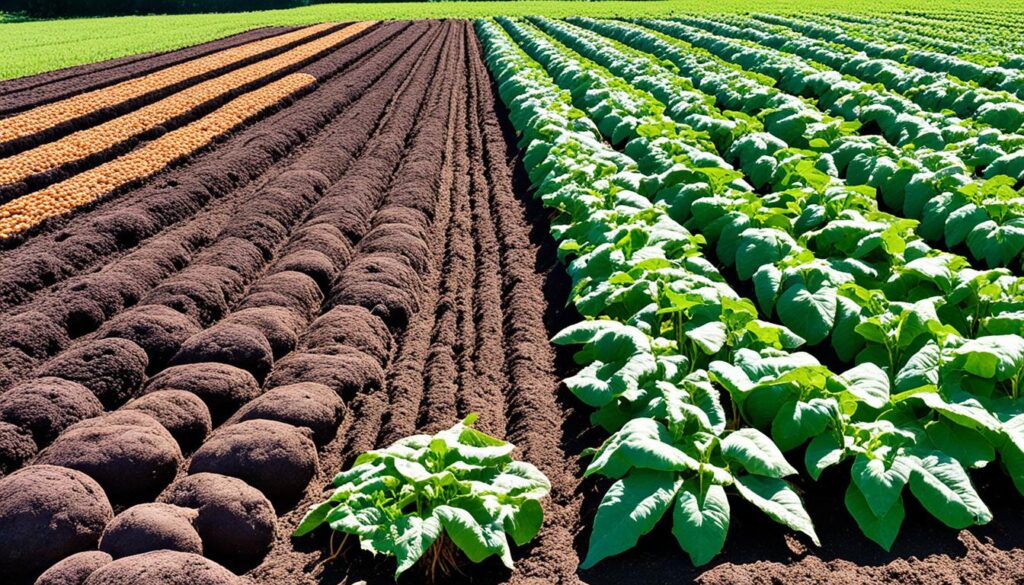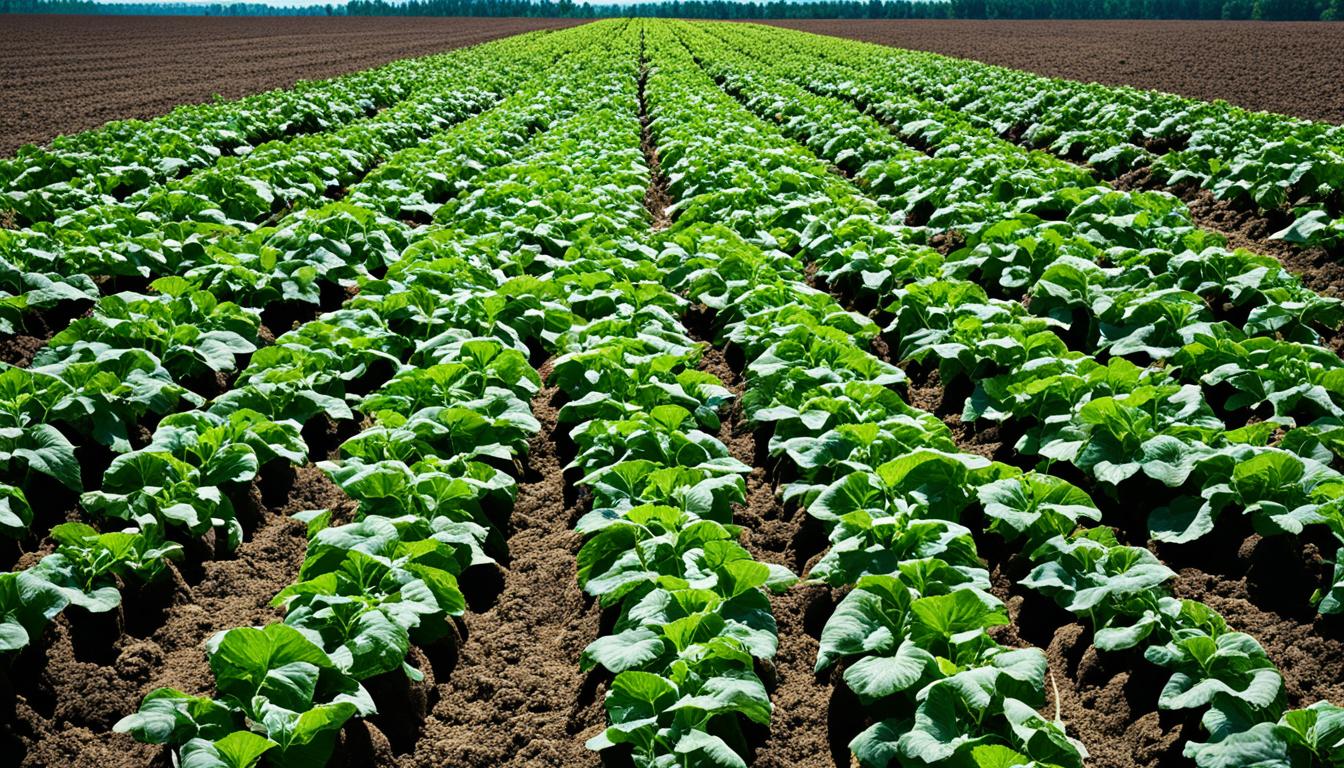Sweet potatoes have long been a beloved vegetable, gracing our tables with their vibrant colors and delicious flavors. But did you know that there is a rich diversity of sweet potato varieties waiting to be explored? And what about yams – are they truly the same as sweet potatoes? In this field guide, we will not only delve into the different types of sweet potatoes but also uncover the truth about yams. Prepare to have your taste buds tingling and your perception challenged as we embark on this sweet potato adventure.
Key Takeaways:
- There are numerous sweet potato varieties, each with its own unique taste and texture.
- Yams and sweet potatoes are not the same – they belong to different plant families.
- Understanding the characteristics of different sweet potato varieties can enhance your cooking experience.
- Proper storage techniques can extend the shelf life of sweet potatoes for up to three months.
- Identifying sweet potatoes can be challenging but is crucial to selecting the right variety for your recipes.
Understanding Sweet Potato Varieties
When it comes to sweet potatoes, the possibilities are endless. With thousands of sweet potato varieties available, each offering its own unique taste and texture, it can be quite a culinary adventure. In this section, we will explore some of the most common sweet potato varieties in the U.S., their distinguishing features, and the delicious flavors they bring to the table.
Common Sweet Potato Varieties
Among the sweet potato varieties found in the U.S., a few stand out as popular choices for both home cooks and chefs. Let’s take a closer look at three of these varieties:
- Beauregard: This variety features purplish-red skin and a deep orange flesh. When cooked, Beauregard sweet potatoes have a slightly stringy texture and are remarkably juicy. This makes them ideal for mashing, baking, and even pies.
- Jewel: Recognizable by their light orange skin, Jewel sweet potatoes have a moist and watery texture. Their vibrant color adds visual appeal to dishes, making them a popular choice for boiling, baking, and casseroles.
- Garnet: With dark orange-red skin and a moist, sweet flesh, garnet sweet potatoes are a favorite for mashing and baking. Their smooth texture and natural sweetness make them a delightful addition to soups, stews, and even desserts.
Of course, these are just a few examples of the sweet potato varieties you can find. Other varieties include the Hannah sweet potato, known for its white flesh and dense, creamy texture. There’s also the Okinawa sweet potato, which boasts a vibrant purple flesh and a mild, slightly nutty flavor.
“With their wide range of textures and flavors, sweet potatoes can transform ordinary dishes into extraordinary culinary experiences. Whether you prefer the creamy richness of Beauregards or the vibrant hues of Okinawa sweet potatoes, there is a sweet potato variety to suit every taste.”
If you’re in need of a visual reference, take a look at the table below, showcasing some common sweet potato varieties and their key characteristics:
| Variety | Skin Color | Flesh Color | Texture | Flavor |
|---|---|---|---|---|
| Beauregard | Purplish-Red | Deep Orange | Slightly Stringy and Juicy | Rich and Sweet |
| Jewel | Light Orange | Orange | Moist and Watery | Naturally Sweet |
| Garnet | Dark Orange-Red | Orange | Moist and Sweet | Flavorful and Slightly Nutty |
| Hannah | Light Brown | White | Dense and Creamy | Mild and Buttery |
| Okinawa | Off-White or Dusty Purple | Purple | Moist and Fluffy | Mild and Slightly Sweet |
Yams vs Sweet Potatoes: The Truth Revealed
Contrary to popular belief, yams and sweet potatoes are not the same thing. Yams are tubers native to Asia and Africa, while sweet potatoes belong to the morning glory family. In the U.S., the term “yam” is often misused and used interchangeably with sweet potatoes. Southern farmers coined the term “yam” to differentiate the orange-fleshed sweet potatoes they were cultivating.
True yams have scaly brown skin and starchy white flesh. They are less sweet than sweet potatoes and are best boiled or slow-braised. It is unlikely that you will accidentally purchase a yam at your local supermarket, as most of the “yams” available are actually sweet potatoes.
| Yams | Sweet Potatoes |
|---|---|
| Native to Asia and Africa | Belong to the morning glory family |
| Scaly brown skin | Smooth skin in various colors |
| Starchy white flesh | Moist or dry flesh in various colors |
| Less sweet | Sweet flavor |
| Best boiled or slow-braised | Versatile for various cooking methods |
Yam nutrition facts:
- Low in fat and cholesterol.
- High in fiber and potassium.
- Good source of Vitamin C, Vitamin B6, and manganese.
- Contains antioxidants that promote a healthy immune system.
Popular yam varieties:
- African yam (Dioscorea rotundata)
- Asian yam (Dioscorea opposita)
- White yam (Dioscorea alata)
- Yellow yam (Dioscorea cayenensis)

How to Identify Sweet Potatoes
Identifying sweet potatoes can be challenging, as they come in various skin colors and flesh colors. The most common sweet potato variety in American grocery stores is the Beauregard, which has purplish-red skin and deep orange flesh. Jewels have light orange skin, while garnets have dark orange-red skin. White-fleshed sweet potatoes like the Hannah have light brown skins and white flesh. Okinawa sweet potatoes have off-white or dusty purple skins and vibrant purple flesh.
To distinguish sweet potatoes from yams, look for red or orange flesh and thinner, smoother skin in sweet potatoes, while true yams have white flesh and thicker, rougher skin.
| Sweet Potato Variety | Skin Color | Flesh Color |
|---|---|---|
| Beauregard | Purplish-red | Deep orange |
| Jewel | Light orange | Yellow-orange |
| Garnet | Dark orange-red | Dark orange |
| Hannah | Light brown | White |
| Okinawa | Off-white or dusty purple | Vibrant purple |
Best Practices for Sweet Potato Storage
To ensure the longevity of your sweet potatoes, it is essential to follow proper storage practices. By implementing the right techniques, you can preserve the quality and flavor of your sweet potatoes for an extended period. Here are our recommended best practices for sweet potato storage:
- Curing after Harvest:
After harvesting sweet potatoes, the first step is to cure them. Curing is a process that converts the starches in the sweet potatoes into sugars, resulting in enhanced flavor and texture. To cure sweet potatoes, follow these steps:
- Place the sweet potatoes in a warm and humid environment, ideally at a temperature of 80-85°F and humidity levels of 85-90%.
- Let the sweet potatoes cure for approximately two weeks, allowing the sugars to develop and the flavors to intensify.
- Proper Storage Conditions:
After curing, it is crucial to store the sweet potatoes correctly to maintain their quality. Follow these guidelines for storing sweet potatoes:
- Find a dark place with a consistent temperature of 50-60°F to store your sweet potatoes. Basements, cellars, or cool, dry pantry areas are suitable locations.
- Avoid storing sweet potatoes in areas with high humidity or extreme temperature fluctuations.
- Handling and Preparing Sweet Potatoes for Storage:
Proper handling before storage is essential in preserving sweet potatoes. Here are some tips:
- Do not wash the sweet potatoes before storing them. Washing can introduce moisture, promoting decay during storage.
- Inspect the sweet potatoes and remove any damaged or bruised ones. Damaged sweet potatoes can contribute to the spoilage of the whole batch.
- Avoid exposing the sweet potatoes to direct sunlight, which can cause sprouting or green spots.
Following these best practices will help you maintain the quality of your sweet potatoes and extend their shelf life for up to three months.
For a visual representation of the best practices for sweet potato storage, refer to the table below:
| Step | Storage Practices |
|---|---|
| Curing after Harvest | Store sweet potatoes in a warm (80-85°F) and humid (85-90%) environment for two weeks |
| Proper Storage Conditions | Keep sweet potatoes in a dark place with a temperature of 50-60°F |
| Handling and Preparing Sweet Potatoes for Storage | Avoid washing sweet potatoes before storage, remove damaged ones, and protect from direct sunlight |
Implementing these sweet potato storage best practices will ensure that you can enjoy the delicious flavor of your sweet potatoes for months to come.
Conclusion
Sweet potatoes are a versatile and flavorful vegetable that comes in a variety of types and colors. Whether you’re a fan of the rich orange-fleshed Beauregards, the light and watery Jewels, or the vibrant purple Okinawa sweet potatoes, there is a sweet potato variety to suit every taste.
It is important to understand the distinction between sweet potatoes and yams. While the two terms are often used interchangeably, yams are actually a different tuberous vegetable native to Asia and Africa. True yams have scaly brown skin, starchy white flesh, and are less sweet compared to sweet potatoes. Most of the “yams” available in supermarkets are, in fact, sweet potatoes mislabeled as yams.
To preserve the freshness of sweet potatoes, proper storage is crucial. After harvesting, it is recommended to cure sweet potatoes by storing them in a warm and humid environment for two weeks. This process converts starch to sugar and enhances their flavor. Subsequently, store the sweet potatoes in a dark place with a temperature of 50-60°F, ensuring they are not washed before storage to prevent decay. By adhering to these storage best practices, you can enjoy sweet potatoes year-round.
